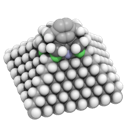Frequently Asked Questions - 2


Uncertainty
How do you know that in real life the atoms in the pictures you show will actually form into the shapes you show?
-
Each of these molecules has been optimized or energy minimized. This means that once you put all the atoms together into a certain position they move around a little bit, just like a marble in a bowl, trying to find the lowest point. (This only takes a small fraction of a second.)
You talk about diamond as if it is very strong, but everyone knows you can easily crush diamond with a steel hammer. If Buckymesh is not as strong as diamond, then it can't be much good for anything.
-
Nearly everyone thinks of diamond in its natural form, like on wedding rings. Natural diamond has lots of imperfections, like a maze of fault lines in the earth's surface. A bit of pressure and the diamond cracks along one of these lines. This is what makes it brittle.
I thought each carbon atom likes to have four bonds, not three as the single-walled versions seem to have.
-
Correct. Every third bond is actually a double bond, for a total of four bonds per carbon atom. Or more accurately, every bond is an aromatic one (or graphitic, which is slightly shorter), which also totals four bonds. Each molecule has a total zero charge (just the right number of electrons).
OK, maybe this could work, but there are very few computers (if any) that could keep track of the location of every one of a thousand, million, billion atoms.
-
True, however you don't need to. You only need to know where the atoms are in a nanotube, where the nanotubes go in a nanojack, where the nanojacks go in a super-nanojack, and so on up through the levels. The program could actually be relatively straightforward, using fixed atom positions up to super-nanojacks and recursion for all higher levels.
How do you actually cut a buckyball in half?
-
The design does not detail a method of construction, it is only there to help understand the structure of the final molecule. I don't know how you would cut a buckyball in half, but I would guess that someone might know. (You would probably use something like this Carbon Transfer Tooltip.)
-
Perfect synthetic diamond, better than that produced today (every atom in exactly the right place), has no imperfections and is not brittle. Rather it is shatterproof, stronger than any other known material (including Buckymesh, which is not as strong but has a much higher strength to weight ratio). We just don't know how to make it (in large quantities) yet. But it is probable that we will. (Also, any small amount of material, no matter how strong, will break given enough force: spider silk is strong, but you can brush it away with your fingers because it is so thin.)





